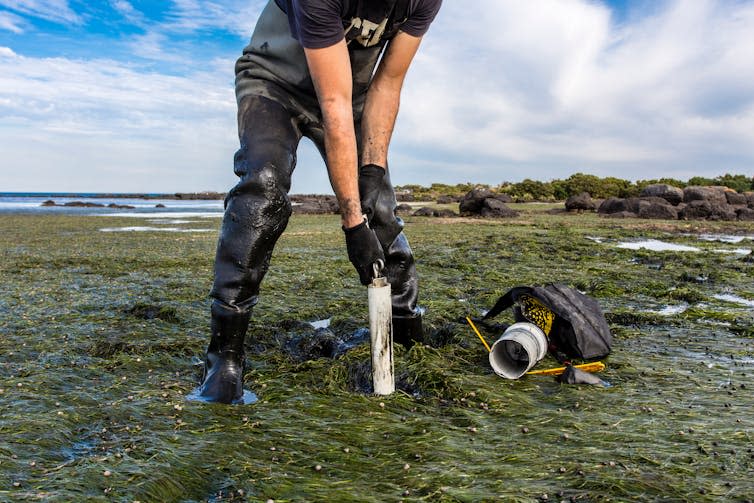“The science we need for the ocean we want” – this is the motto of the UN Decade of Oceans (2021-2030), which is holding its first conference in Barcelona, Spain. Marine scientists from around the world, including me, joined with global leaders to plan the progress of this decade-long mission to improve ocean health and marine biodiversity. This includes finding ways to better protect the seabed, about which we still know very little.
Some sediment areas on the seafloor contain large carbon stores. Unless greater protection is provided, disruptions, for example from bottom trawling practices, could cause some of the stored carbon to be released back into the atmosphere.
In Barcelona, I participated in discussions that led to the launch of a new sustainable ocean planning initiative to be coordinated by Julian Barbière, global coordinator of the Decade of Oceans. It aims to promote commitment to the sustainable management of 100% of the marine area under a country’s jurisdiction.
Once this happens, we have room to reimagine the ocean’s role in our broader climate system and recognize that all marine natural systems sequester and store carbon in their soils and sediments.
I am here on behalf of the global ocean decadal program for blue carbon; this is any carbon stored in the ocean. This project is one of the UN’s 50 programs that aim to deliver transformative ocean science solutions for sustainable development, connecting people and our oceans. This is a big question.
My work focuses on the extraordinary ability of coastal ecosystems such as mangroves, salt marshes, and seagrass meadows to sequester or store organic carbon at unusually high concentrations. Our blue carbon team of international research scientists from more than 20 countries is beginning to identify emerging blue carbon ecosystems, such as kelp forest and subtidal sediments, as solutions to managing the climate and biodiversity crises.
From coastal seagrass meadows to sediment slowly accumulating in the deepest trenches, 360 million square kilometers of ocean and seafloor are largely ignored as a valuable store of carbon. Oceans have vast stores of carbon; The upper meter of ocean holds an estimated 2.3 trillion metric tons.
The seabed is not a resource to be endlessly exploited, but a vulnerable reservoir of global biodiversity and carbon that must be protected. These highly productive but vulnerable ecosystems have been greatly impacted by habitat loss and destructive practices, such as the deforestation of mangroves for shrimp farming, during the incessant development of the world’s coastal regions.
Blue carbon has great potential to provide ocean-based solutions to help mitigate climate change, and thankfully, at least on a global scale, these losses have slowed in recent years.
Blue carbon’s potential to reduce greenhouse gas emissions is relatively modest, but healthy, restored ecosystems have the potential to store an additional 2.96 million tonnes of carbon per year. Some countries, such as Indonesia, offer great potential as blue carbon hotspots where nature conservation and restoration is an opportunity for both the environment and local communities.
Carbon credits, which enable additional carbon to become a source of investment income, are of great interest in this society. The community-based Miko Pamojo project off the coast of Kenya is increasing the direct benefits to local people from mangrove restoration.

Blue carbon ecosystems can help countries meet their climate obligations and are attracting great interest. But if nations want these ecosystems to continue providing a wide range of services, our governments must protect them and, if possible, restore lost habitats.
Most governments have been stubbornly slow to prioritize ocean-based solutions on the agenda of global climate negotiations. At this conference, I heard from more people, including Unesco’s director general, Audrey Azoulay, who are highlighting the need to protect and effectively manage our ocean resources.
Members of the traditional owners of the Great Barrier Reef spoke of “country” from the perspective of a long and continuous human relationship with nature and were intimately connected to the ocean. There is growing recognition and respect for this indigenous knowledge and our need to integrate it into a sustainable ocean future.
Reimagining the ocean’s role
It makes sense to start by protecting these natural systems that already host vulnerable carbon stores; This is sensible risk management.
As nations continue to exploit the marine environment for fisheries, fossil fuels, and even precious metals mined from the seabed in certain locations, it is time to rethink the value of these vast stores of natural ocean carbon.
Space science receives far more funding than our oceans, but large areas of the global deep ocean remain largely unmapped. “Life below water” is by far the least funded of the UN’s 17 Sustainable Development Goals. This needs to change with sustained and increasing investment in ocean science and greater recognition of the value of our blue economy, defined by the UN as the sustainable use of ocean resources for economic growth, improved livelihoods and jobs.
Pausing and stepping back to protect what already exists in the ocean can help the planet and us build resilience and create a healthier and more sustainable marine environment. The seabed forms the basis of an interconnected ocean ecosystem and acts as an important long-term global carbon sink, comprising the entire ocean and its exchanges with the atmosphere and the wider Earth system.
While plans are finally moving in the right direction, there are major challenges ahead. To quote Cynthia Barzuna, director of 2030 ocean action at the World Resources Institute, “there is no rich ocean without a healthy ocean.” The biggest takeaway from the Barcelona conference is that a sustainable ocean future depends on a shared vision that works for all of us, and for marine life too.
This article is republished from The Conversation under a Creative Commons license. Read the original article.


William Austin receives funding from UKRI’s Natural Environment Research Council, Horizon Europe, Scottish Government, Defra, Natural England, Nature Scot, Scottish Marine Environment Improvement Fund, Blue Marine Foundation and WWF.